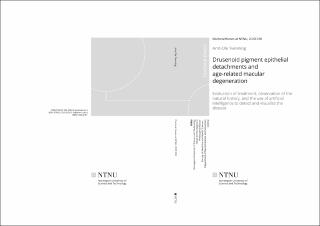| dc.contributor.advisor | Austeng, Dordi | |
| dc.contributor.advisor | Krohn, Jørgen | |
| dc.contributor.author | Tvenning, Arnt-Ole | |
| dc.date.accessioned | 2020-10-13T07:10:51Z | |
| dc.date.available | 2020-10-13T07:10:51Z | |
| dc.date.issued | 2020 | |
| dc.identifier.isbn | 978-82-326-5003-3 | |
| dc.identifier.issn | 1503-8181 | |
| dc.identifier.uri | https://hdl.handle.net/11250/2682332 | |
| dc.description.abstract | Patients with age-related macular degeneration (AMD) and serous or drusenoid pigment epithelial detachments (PEDs) have a high risk of progression to geographic atrophy, choroidal neovascularization, and a loss of visual function. The abundance of lipids and proteins constituting drusenoid PEDs makes it challenging to visualize the choroidal blood circulation and probably also the choroidal neovascularization with the imaging technology available today. Case reports and studies have shown that treatment of serous and drusenoid PEDs with anti-vascular endothelial growth factor (anti-VEGF) or photodynamic therapy (PDT) could stabilize or improve visual function in the absence of choroidal neovascularization on angiography. There were none randomized controlled trials that had tested treatment with anti-VEGF or PDT for serous or drusenoid PEDs, and this was the foundation for our first study. However, most of the patients with serous PEDs were ineligible because of CNV, and one patient had a misdiagnosis and was excluded from statistical analysis because of central serous chorioretinopathy. In addition, new studies described precursors of end-stage geographic atrophy on spectral-domain optical coherence tomography (SD-OCT), and because 75 % of the included patients were in the progression of atrophy, further inclusion and treatment were stopped. The ability to describe atrophy on SD-OCT years before they were visible on color fundus photography made it evident that the knowledge about the natural history of drusenoid PEDs with today’s imaging technology was insufficient, and the prospective observational Norwegian Pigment Epithelial Detachment Study (NORPED) was formed. The 1-year result showed that there was progressive atrophy with a decrease in best-corrected visual acuity and central retinal thickness during the earlier growth phase of drusenoid PEDs, and none developed choroidal neovascularization. A large amount of data was gathered with multimodal imaging in the NORPED study, some of which are better suited for machine learning. SD-OCT volumes have an abundance of information that could potentially represent new features of AMD. With the collaboration of the Department of Computer Science, we developed a deep learning model to detect AMD, and through the adaptation of a novel high-resolution visualization method, show the points of interest in the images associated with the disease. The deep learning model identified AMD and controls with high performance. Known image regions associated with AMD such as drusen, the photoreceptor layers, and the retinal pigment epithelium layer were points of interest in the SD-OCT image associated with AMD. Interestingly, the retinal nerve fiber and choroid layer were also points of interest, and their association with AMD remains to be determined. High-resolution visualization methods in deep learning do not only provide feedback to the clinician but might also increase our knowledge of the disease. | en_US |
| dc.language.iso | eng | en_US |
| dc.publisher | NTNU | en_US |
| dc.relation.ispartofseries | Doctoral theses at NTNU;2020:328 | |
| dc.relation.haspart | Paper 1: Tvenning, Arnt-Ole; Hedels, Christian; Krohn, Jørgen Gitlesen; Austeng, Dordi. Treatment of large avascular retinal pigment epithelium detachments in age-related macular degeneration with aflibercept, photodynamic therapy, and triamcinolone acetonide. Clinical Ophthalmology 2019 ;Volum 13. s. 233-241
https://doi.org/10.2147/OPTH.S188315
This is an open access article under the terms of the Creative Commons Attribution‐NonCommercial‐NoDerivs License (CC BY-NC 3.0) | en_US |
| dc.relation.haspart | Paper 2: Tvenning, Arnt-Ole; Krohn, Jørgen; Forsaa, Vegard Asgeir; Malmin, Agni; Hedels, Christian; Austeng, Dordi. Drusenoid pigment epithelial detachment volume is associated with a decrease in best‐corrected visual acuity and central retinal thickness: the Norwegian Pigment Epithelial Detachment Study (NORPED) report no. 1. Acta Ophthalmologica 2020 s. 1-8
https://doi.org/10.1111/aos.14423
This is an open access article under the terms of the Creative Commons Attribution‐NonCommercial‐NoDerivs License (CC BY-NC-ND 4.0) | en_US |
| dc.relation.haspart | Paper 3: Tvenning AO and Hanssen S, Austeng D, Morken TS. Retinal nerve fibre and choroid layers are signified as age-related macular degeneration by deep learning in classification of spectral-domain optical coherence tomography macular volumes. | en_US |
| dc.title | Drusenoid pigment epithelial detachments and age-related macular degeneration | en_US |
| dc.type | Doctoral thesis | en_US |
| dc.subject.nsi | VDP::Medical disciplines: 700 | en_US |

